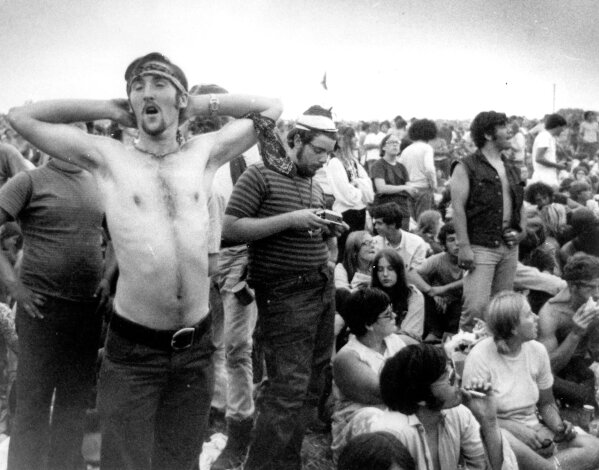Woodstock, Manson and the march to Utopia
NEW YORK (AP) — In the summer of 1969, dreams of a new society played out in muddy wonder at the Woodstock music festival and in murderous parody during the Manson rampage in Los Angeles.
Over a 10-day period in August, hundreds of thousands of young people journeyed to Bethel, New York, and under rainy skies helped give birth to the legend of counterculture paradise at Woodstock. On the other end of the country, a “family” led by an ex-convict and frustrated rock musician launched a hoped-for revolution by plotting and carrying out the slaughter of actress Sharon Tate and six others on consecutive nights.
Timing alone ensured that the Woodstock gathering and the Charles Manson massacre would be joined in memory, opposing codas to the 1960s, a decade endlessly debated and obsessed over. But the apex of peace and love and the abyss of pitiless violence were also born out of similar drives as old as America itself— freedom from guilt and inhibition, a belief in the perfectibility of people and society, a longing for community rooted in the seeming corruption of modern life.
“America has a long and consistent history of communal societies that retreat from the alienation and the perceived immorality of the dominant capitalist culture,” says Adam Morris, whose “American Messiahs: False Prophets of a Damned Nation” came out in March. “You could say both (Manson and Woodstock) came about through a desire, long manifest throughout American history, to bring about a new social order. Obviously the orders imagined by people at Woodstock and people in the Manson family were very different.”
“The utopian dream of restarting history from scratch has been baked into the American experiment from the outset,” says Christopher Jennings, whose “Paradise Now: The Story of American Utopianism,” came out in 2016. “Even though it was obviously a myth, visions of the North American continent as a blank slate upon which any future might be inscribed influenced generations of utopians.”
Ecstasy was in the air in 1969, but so was escape, itself rooted in the possibility of a better world — somewhere. Robert F. Kennedy and Martin Luther King Jr. had been assassinated the year before and the counterculture’s longtime enemy, Richard Nixon, was president. More than half a million American troops remained in Vietnam and reported crimes had more than doubled since 1960.
Joan Didion would remember the Manson murders less as a shock than as a confirmation, writing that as “word of the murders on Cielo Drive (where Sharon Tate lived) traveled like brushfire through the community,” the “tension broke” and “the paranoia was fulfilled.”
Like psychedelic pioneers, hippies were ever exploring. W.J. Rorabaugh, whose historical work “American Hippies” came out in 2015, says that hippies began forming communes in cities, among them New York and San Francisco, in the mid-1960s. They soon shifted to more remote areas and multiplied. By the early 1970s, hundreds of thousands, if not more, lived in some form of commune.
“Some of these communes were political radical communes, and some were just students or other young people sharing rent,” he says. “One mark of a hippie commune is that residents shared clothes, as well as drugs and bodies.”
Woodstock became a kind of spontaneous, mass commune. Festival attendee Todd Strasser recalls that “none of us had any sense of how many of ‘us’ there actually were. Every town and suburban neighborhood had its small share of long-haired freaks and heads, but we were still very much in the minority.” But in Woodstock, the rebels discovered each other. “For once we were the majority! That came as a revelation,” says Strasser, whose novel “The Summer of ’69" came out in April.
Meanwhile, Manson was leading a different kind of commune, organized around his desires and visions. He had been gathering his young outcasts, mostly young women, and convincing them that he was a 20th-century messiah, the eventual ruler of the earth after a climatic war between blacks and whites. It was a commune on the move, fitting for a man who had been in trouble with the law for much of his life. They lived everywhere from the Haight-Asbury district of San Francisco, home in 1967 to the “Summer of Love,” to a former backdrop for movie Westerns, Spahn Ranch, to the home of Beach Boy Dennis Wilson.
At times, you could juxtapose quotes about Woodstock and about Manson and not know who said what.
Joni Mitchell’s “Woodstock,” which later became the festival’s unofficial anthem (even though Mitchell wasn’t there), was a pastoral fantasy in which the singer feels like a “cog in something turning” and finds hope in “going back to the garden.” It’s a sentiment not far from Manson follower Patricia Krenwinkel’s memory of being “just like wood nymphs and wood creatures. We would run through the woods with flowers in our hair, and Charles would have a small flute.” (Manson biographer Jeff Guinn noted that “most often they were miserable and hungry while living in squalor, including long stretches in Death Valley.”)
Manson’s crimes were especially jarring because, at least on the surface, he seemed like a hippie himself, with his long hair and beard, his advocacy of sex and drugs and his belief in the social power of rock lyrics. Manson took what had been the benign, if often misguided pastime of analyzing Beatles songs and twisted it into a summons for mayhem, finding apocalyptic messages in George Harrison’s “Piggies” and Paul McCartney’s “Helter Skelter.”
Guinn notes that Manson himself “absolutely disdained hippies.”
“Hippies espoused peace and love. Manson taught his followers that death is the same as life, and armed them all with buck knives,” Guinn said, adding that Manson likely would have had no use for Woodstock.
“Since the Beatles and Manson — to his mind, the only important musicians on the planet — weren’t performing at Woodstock, Manson would have considered the festival completely unworthy of interest,” he said.




